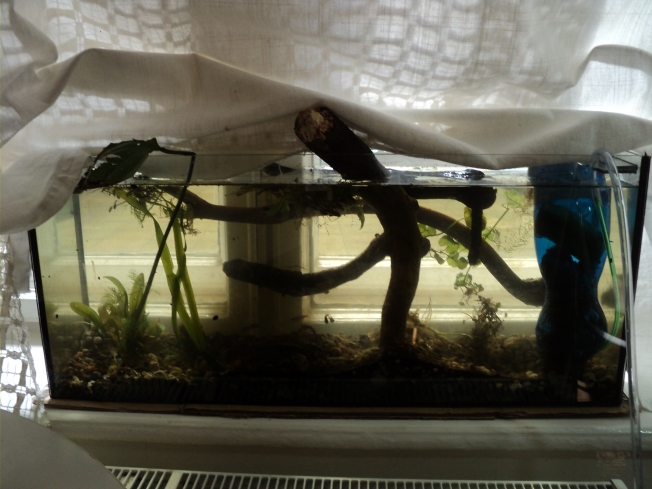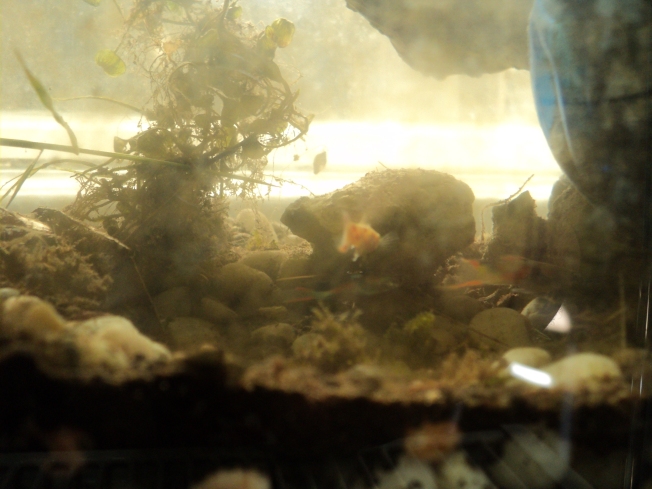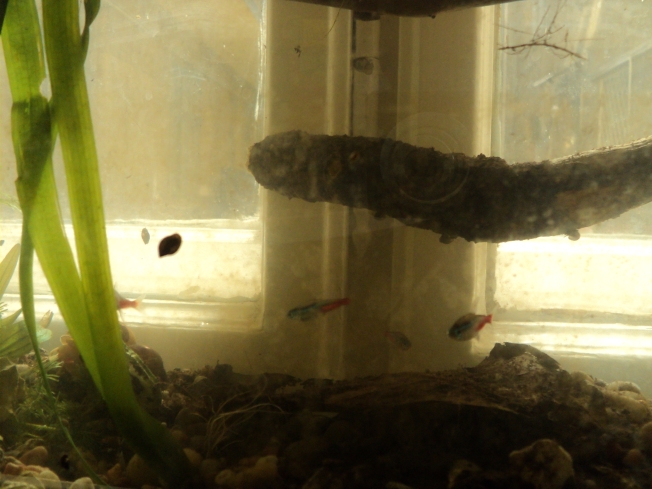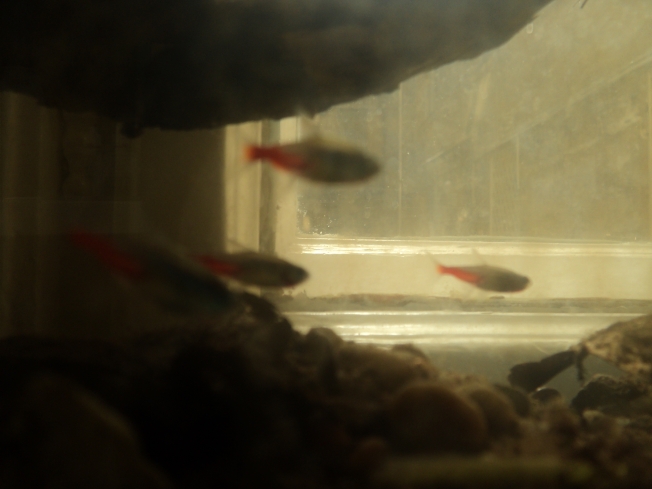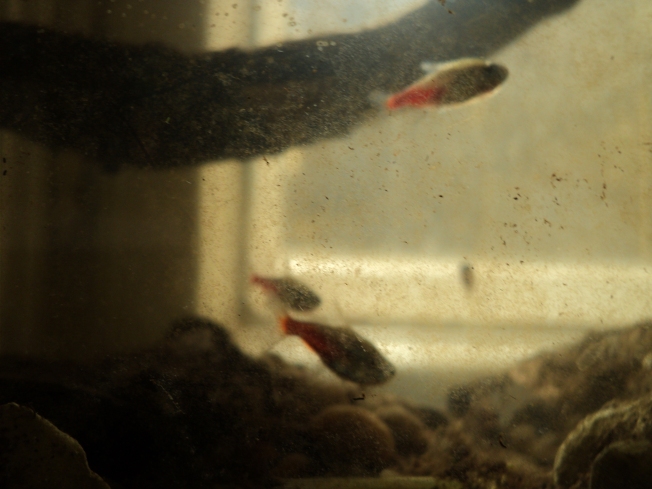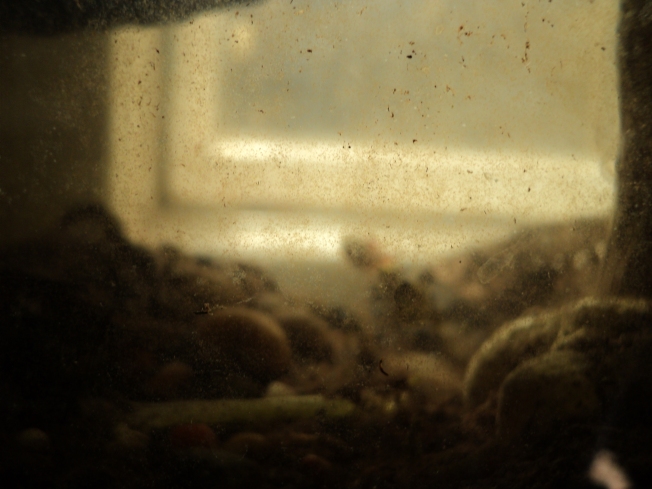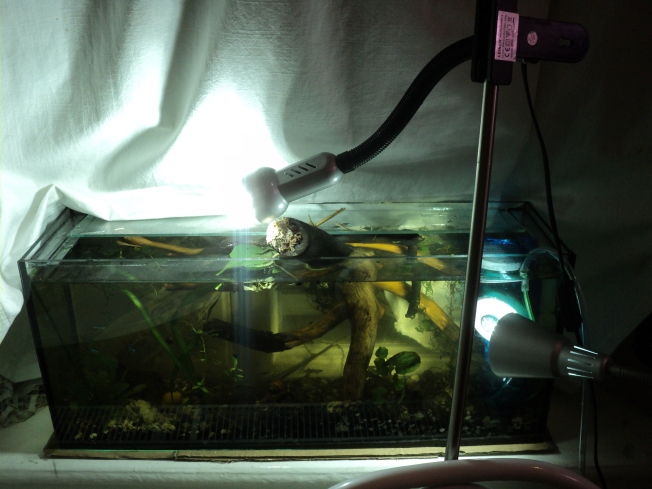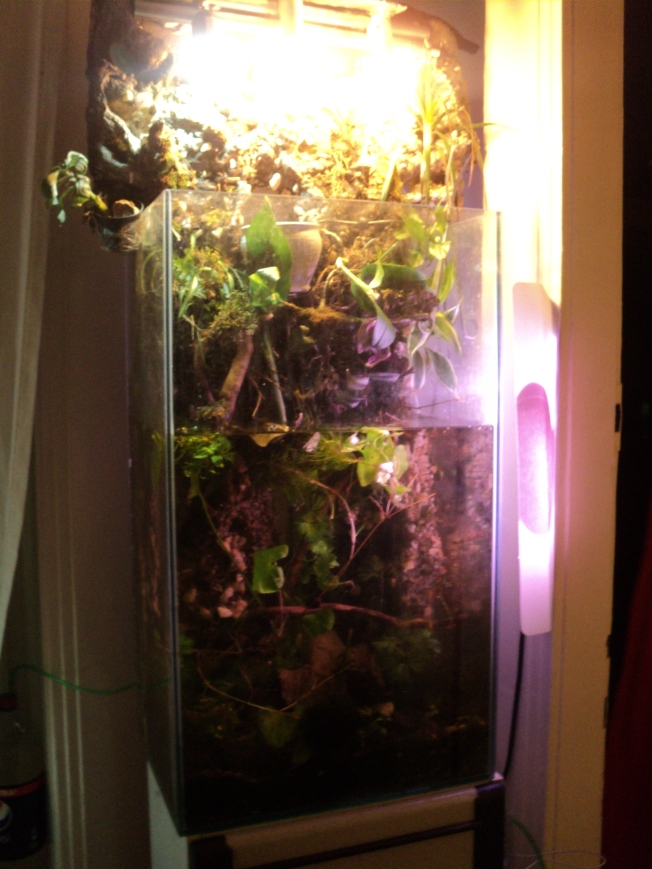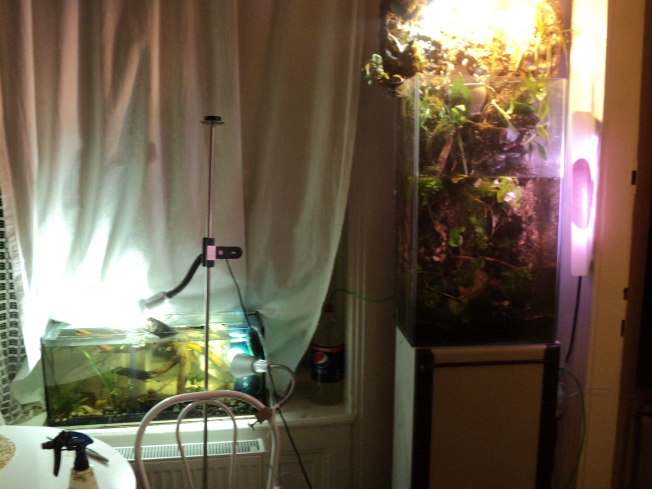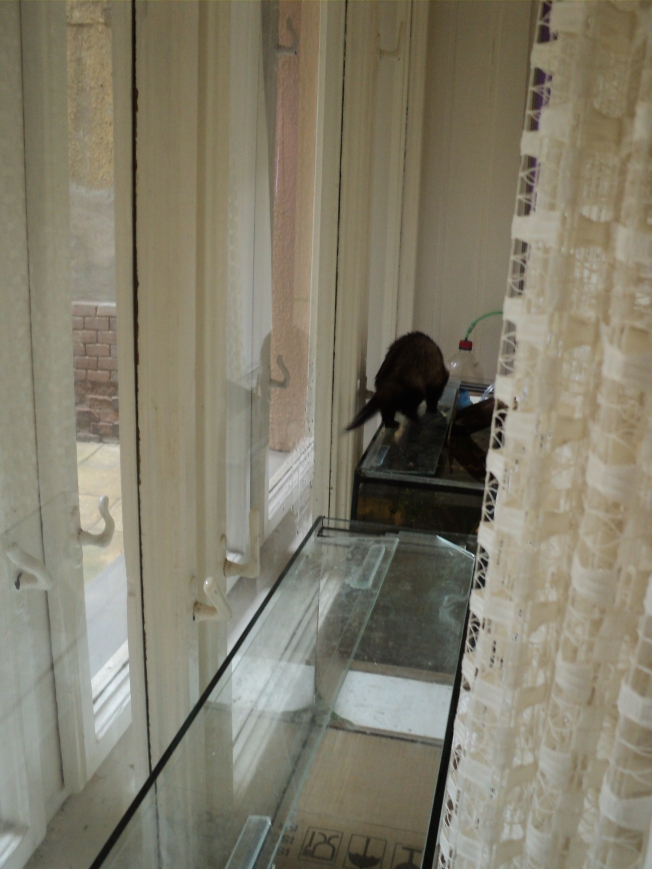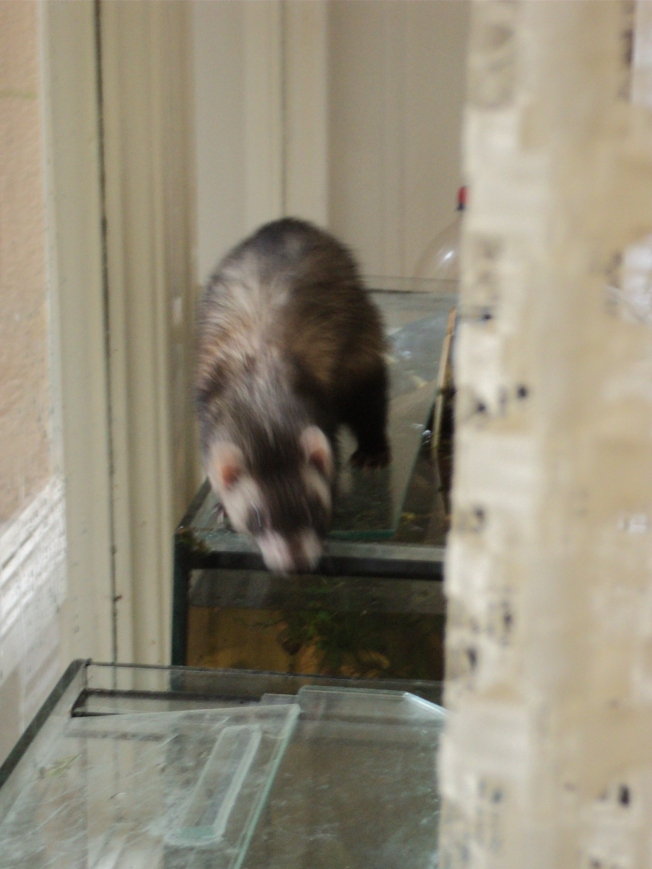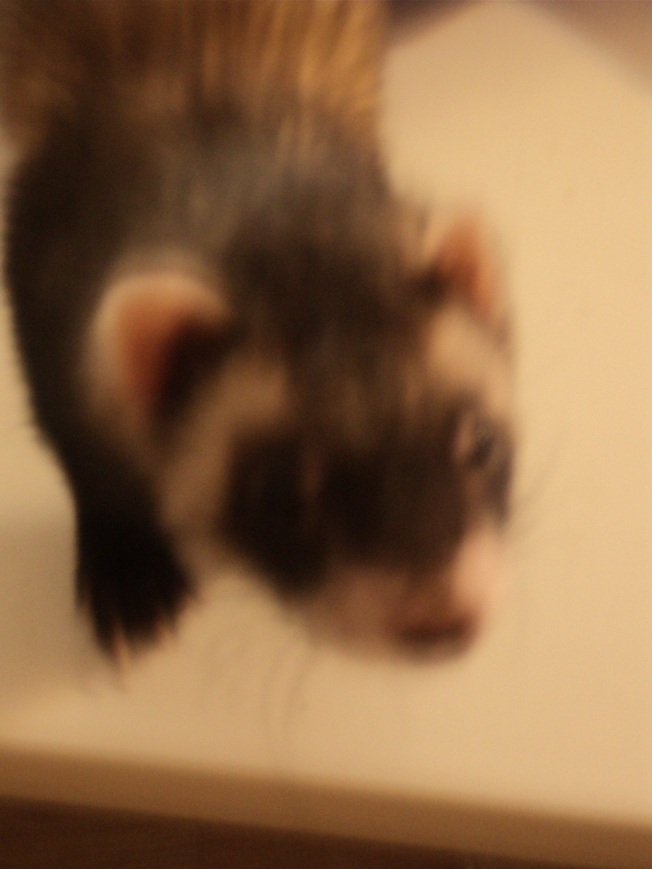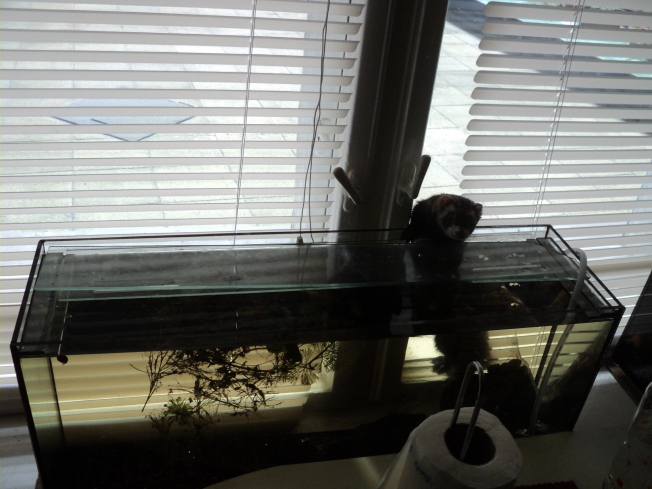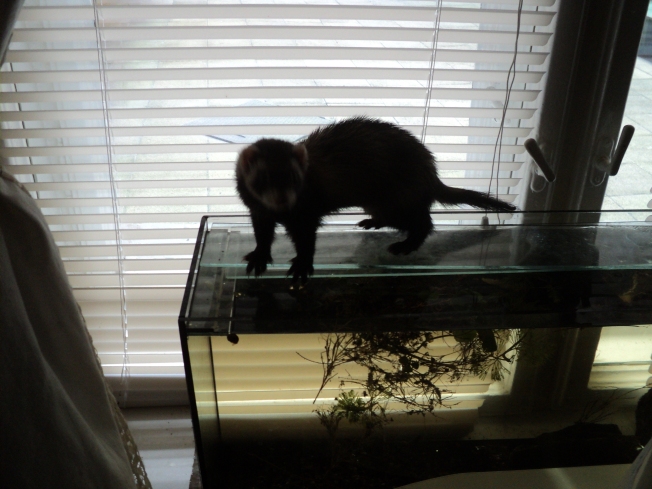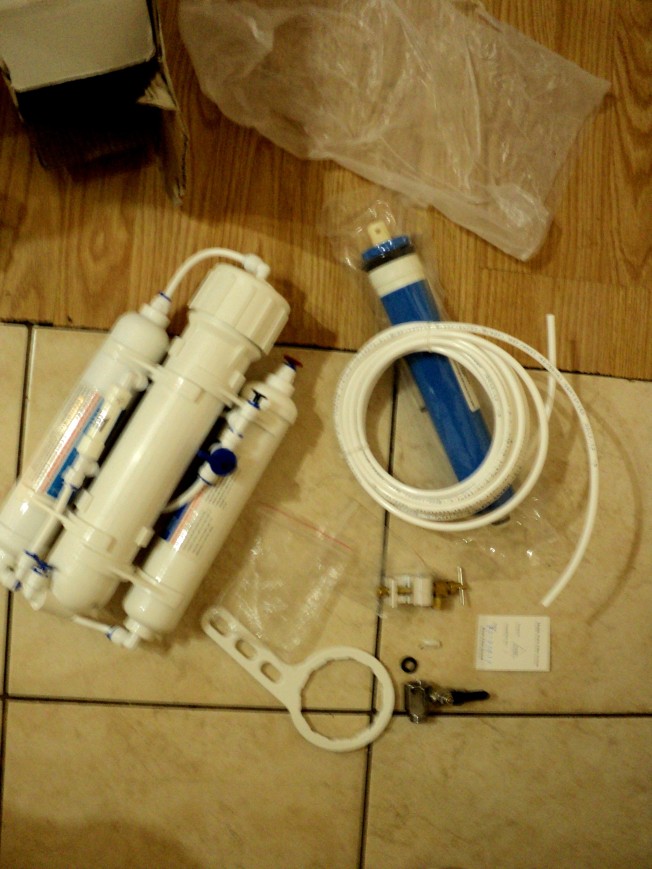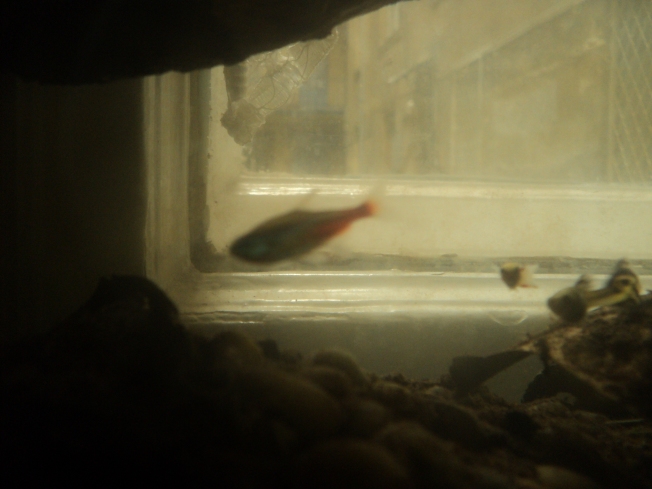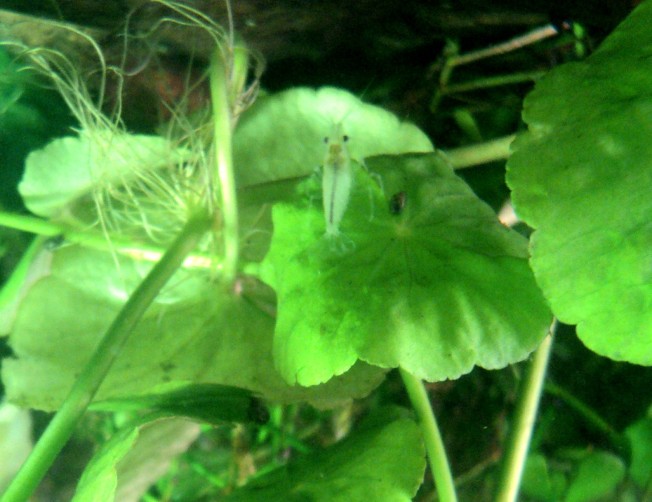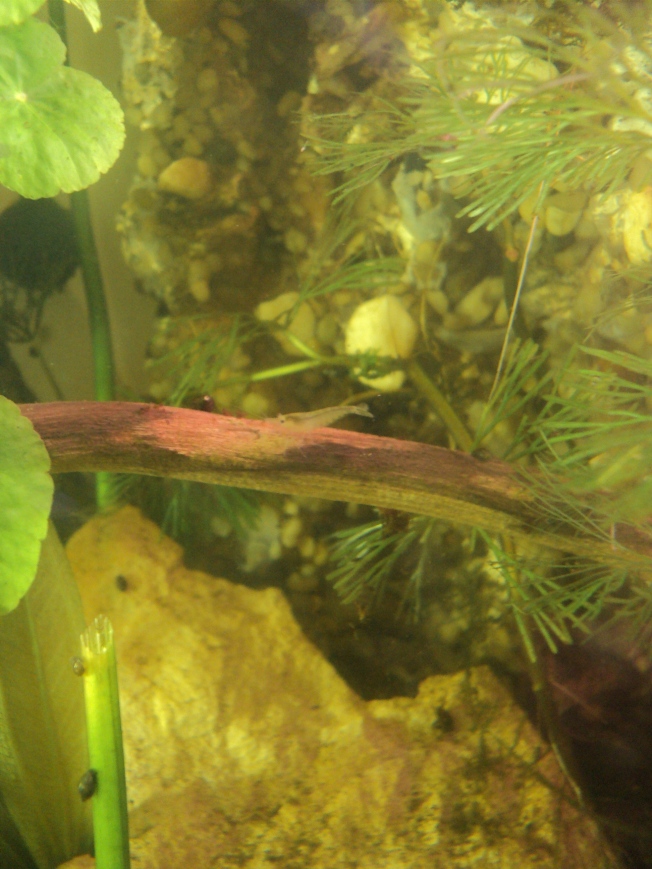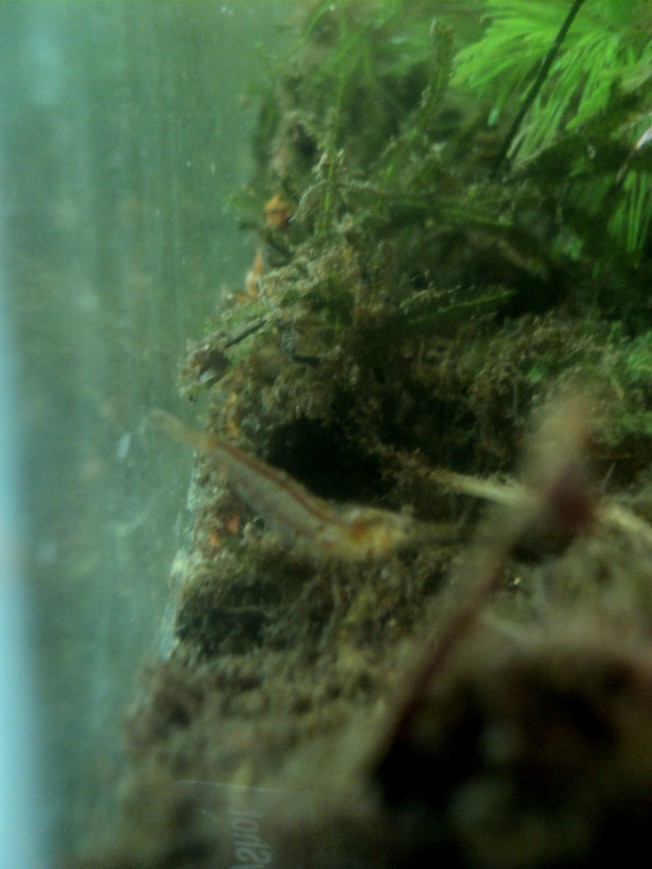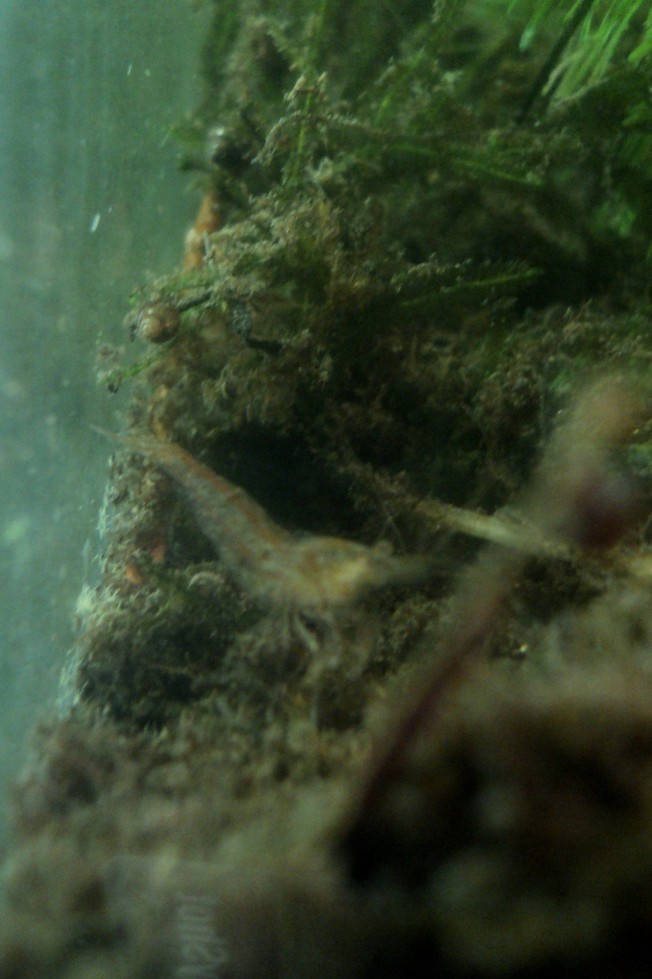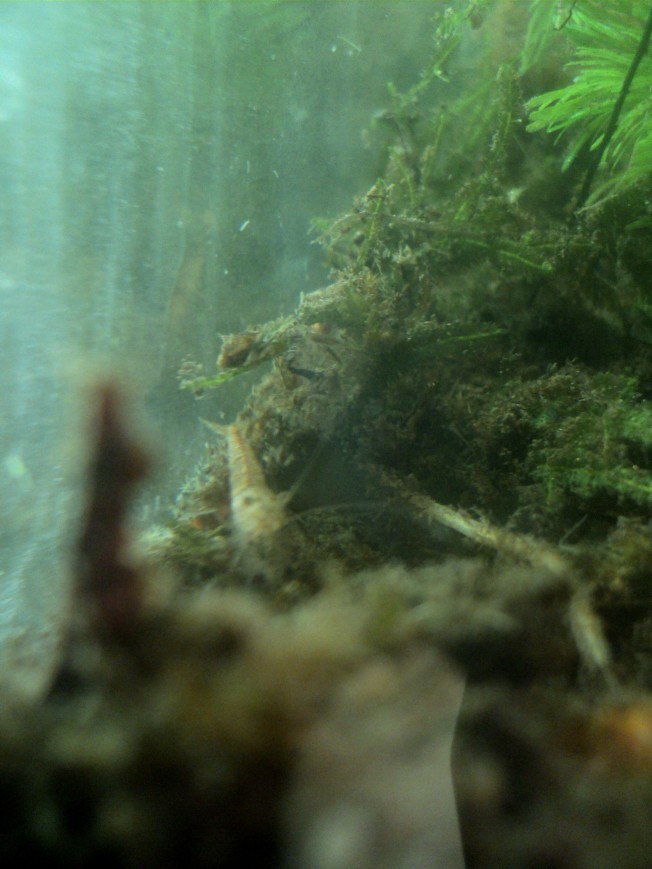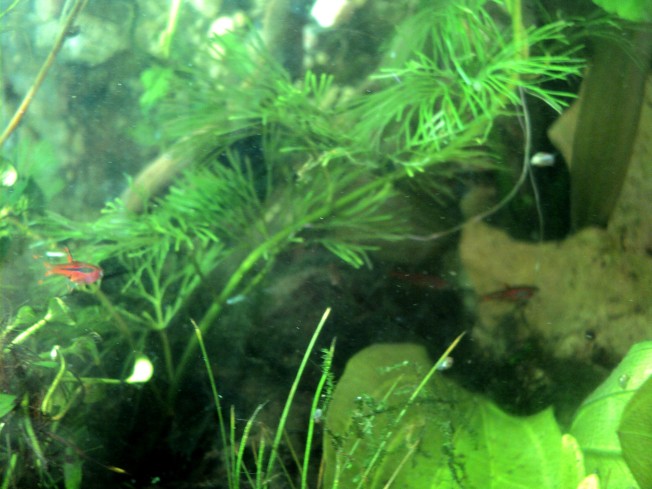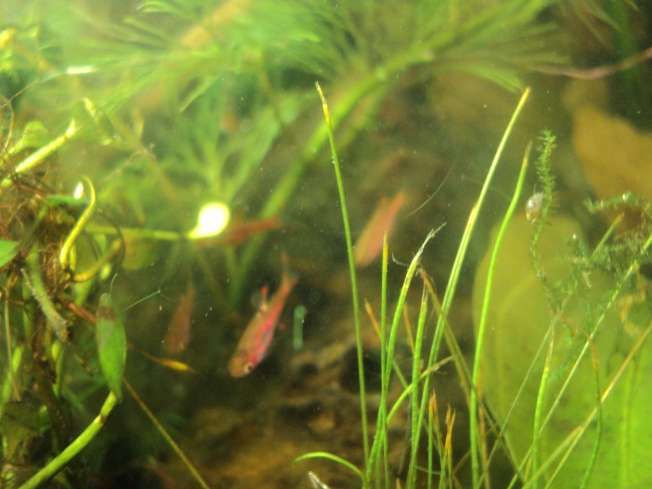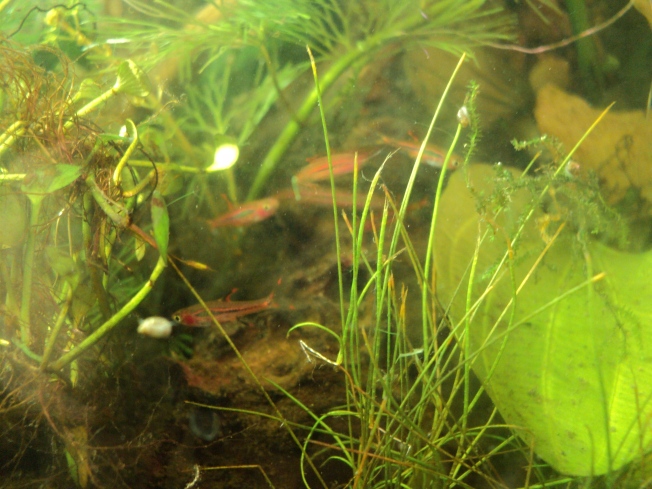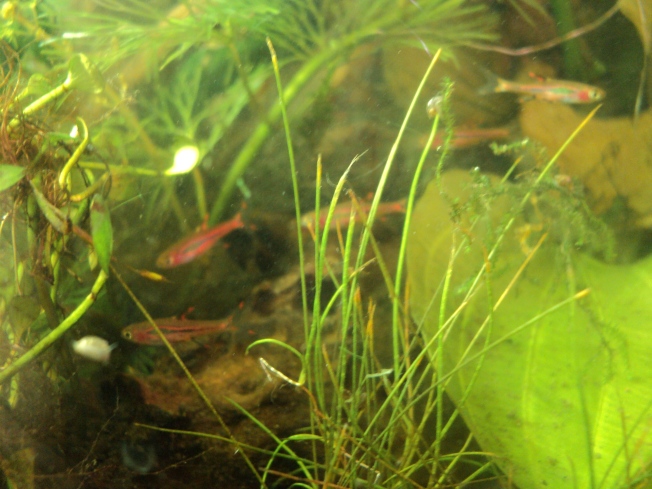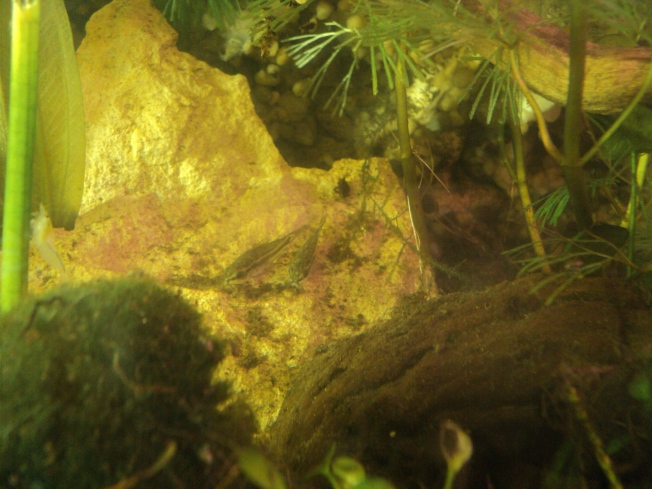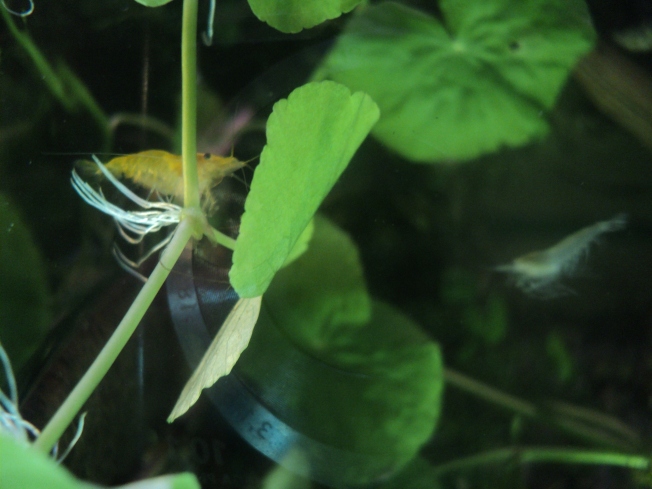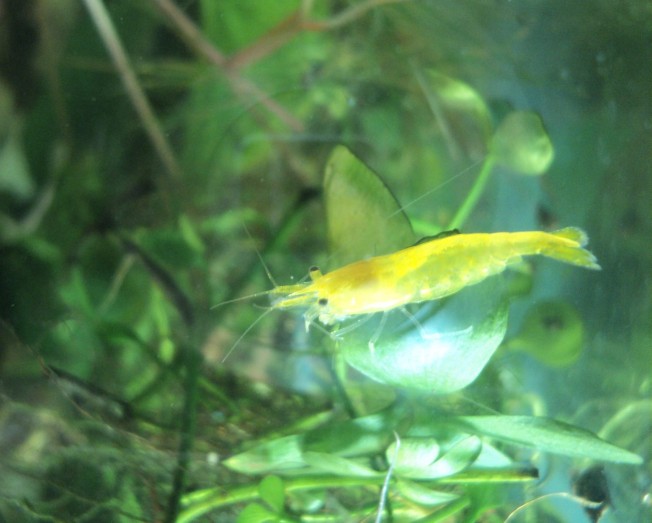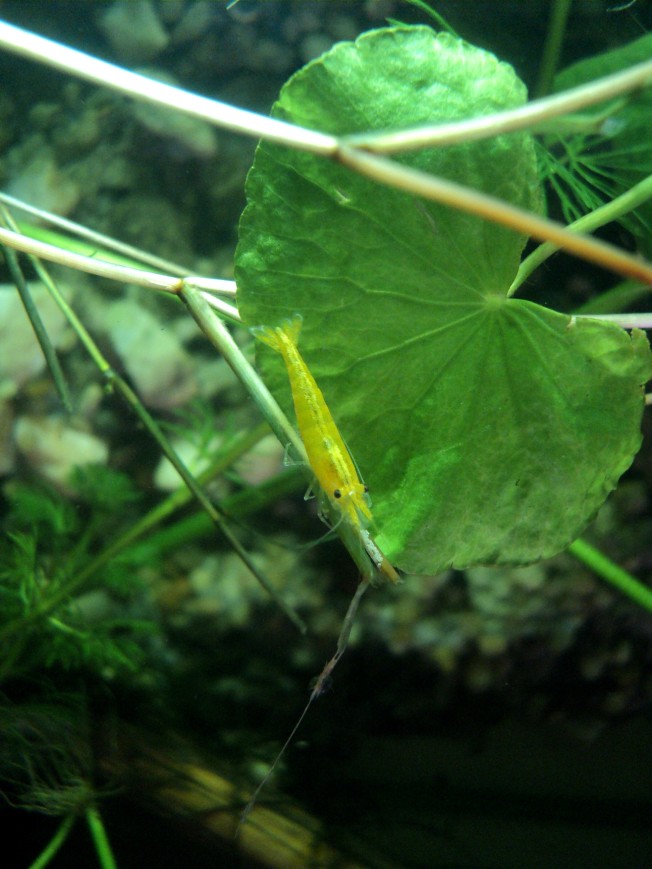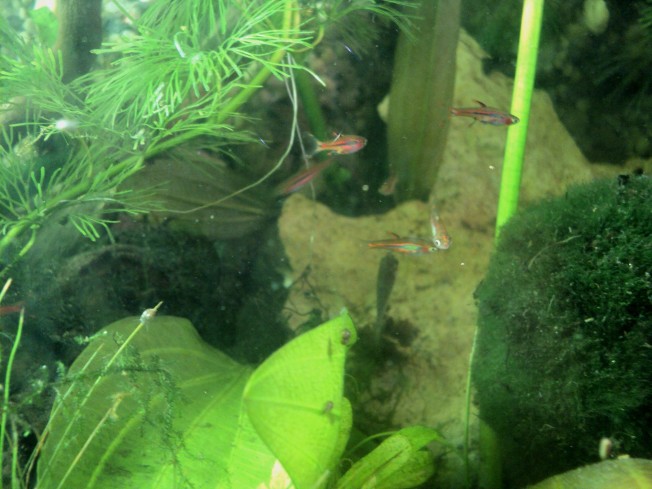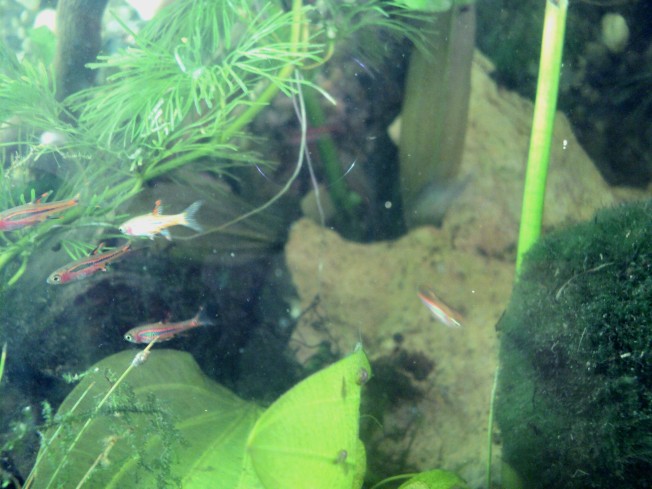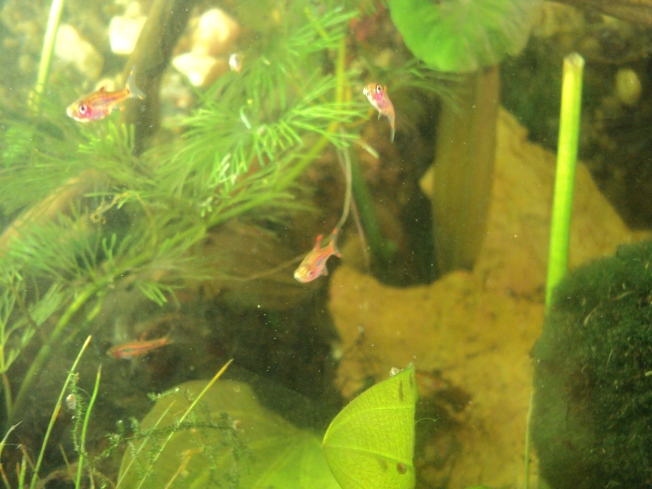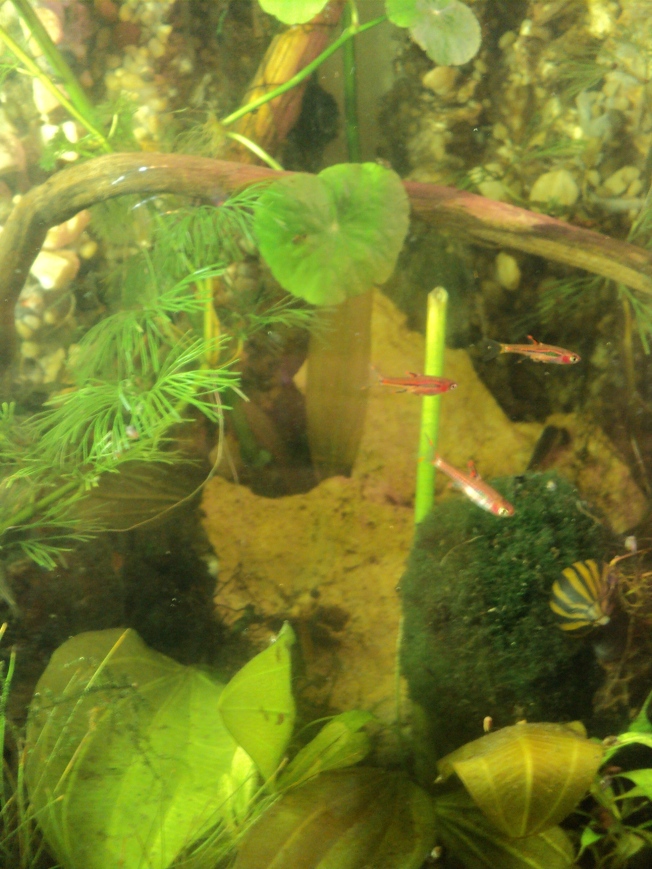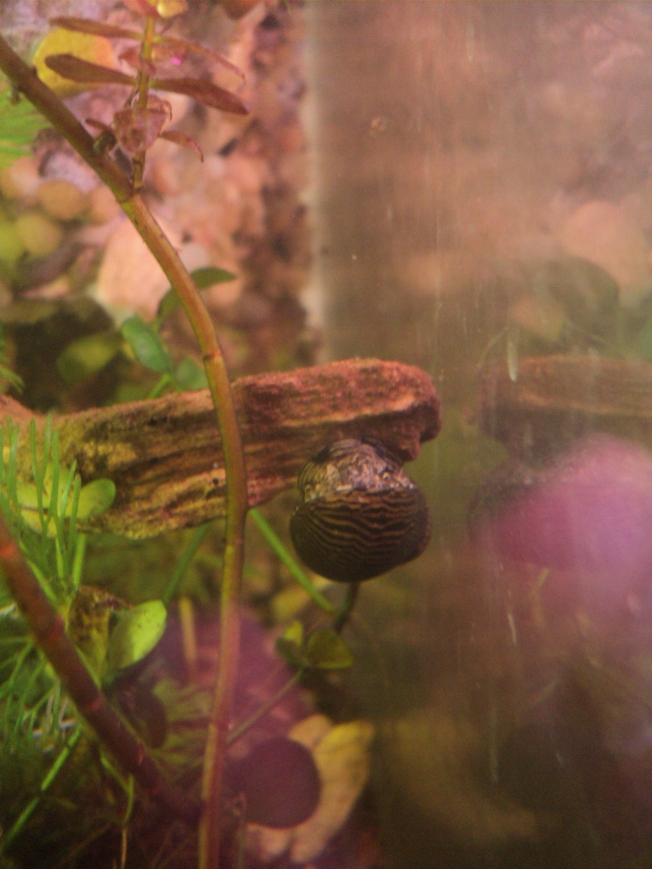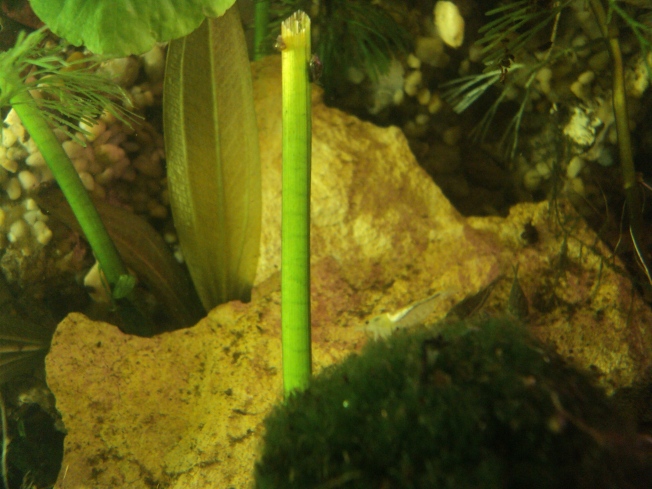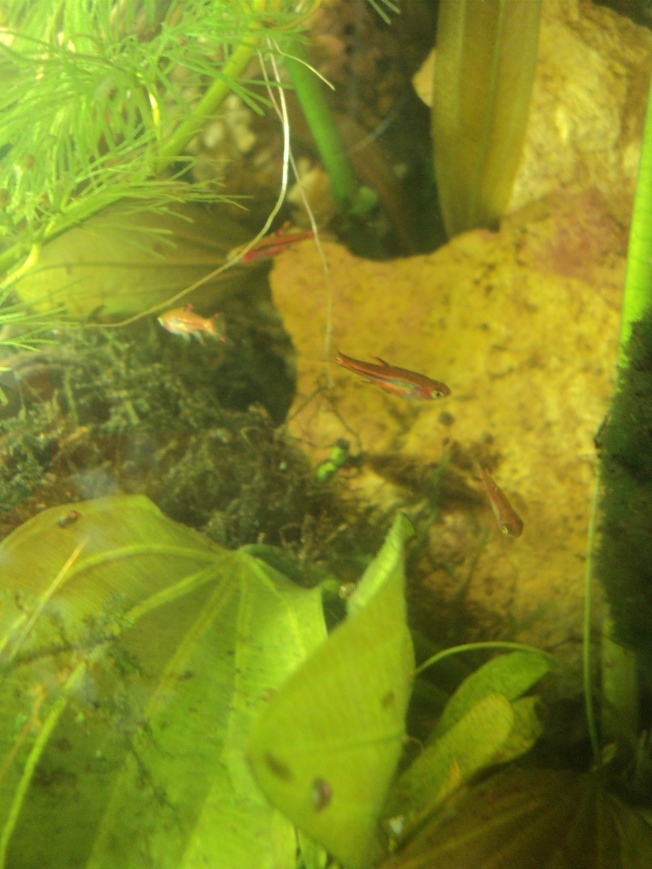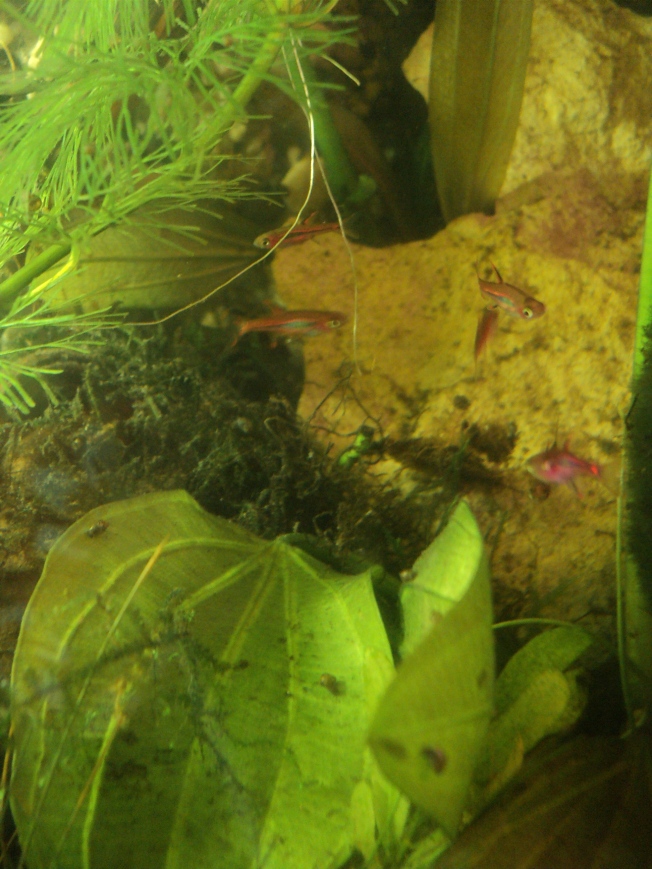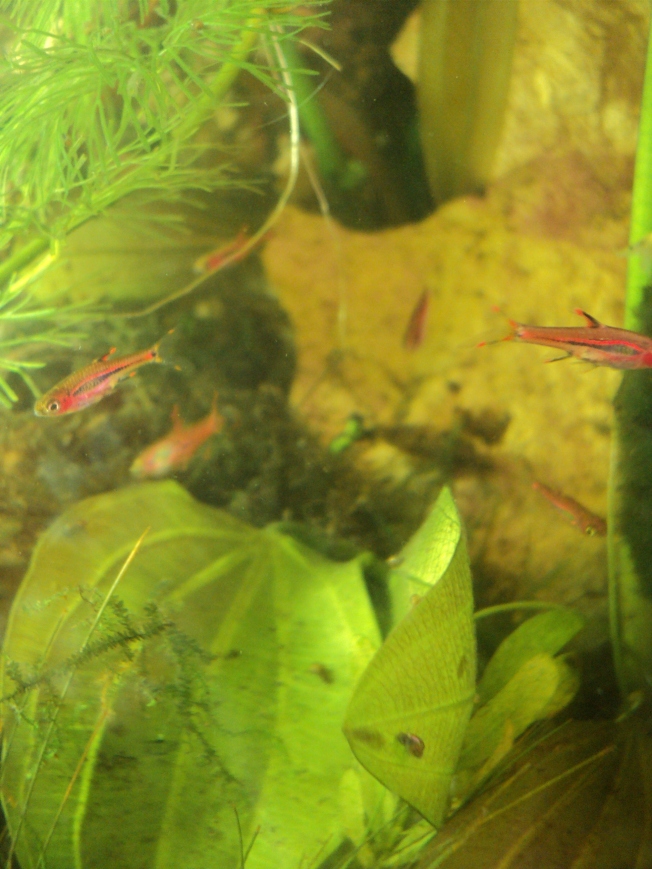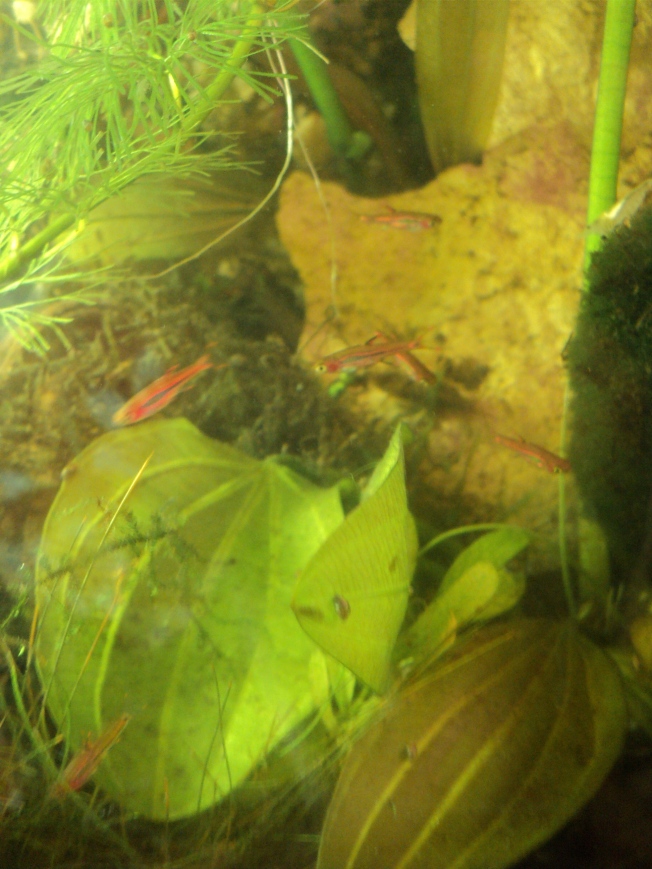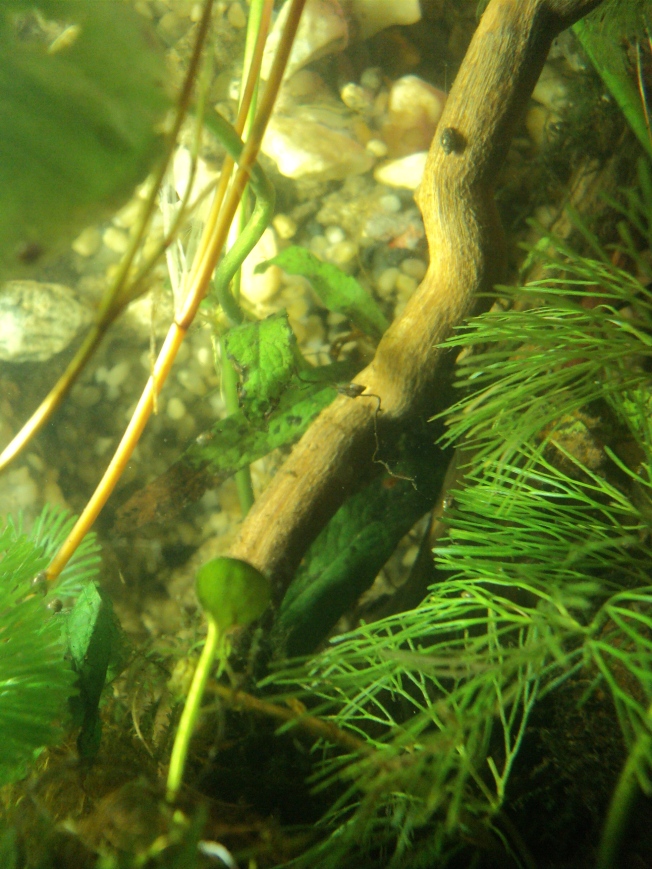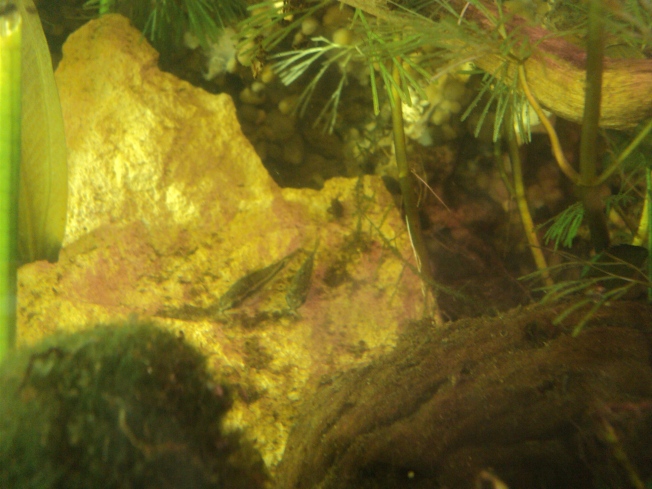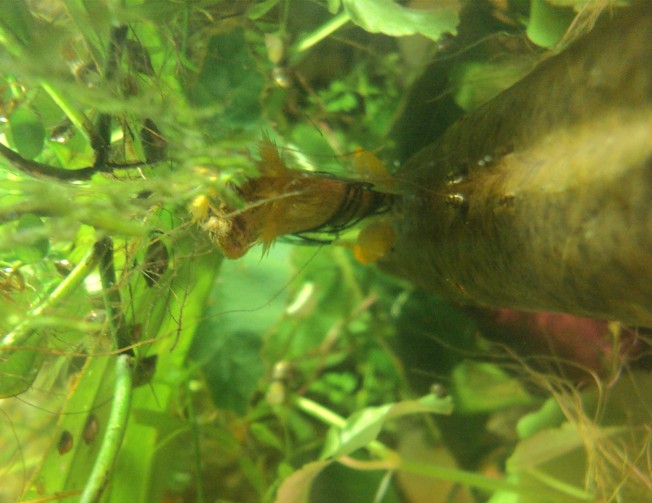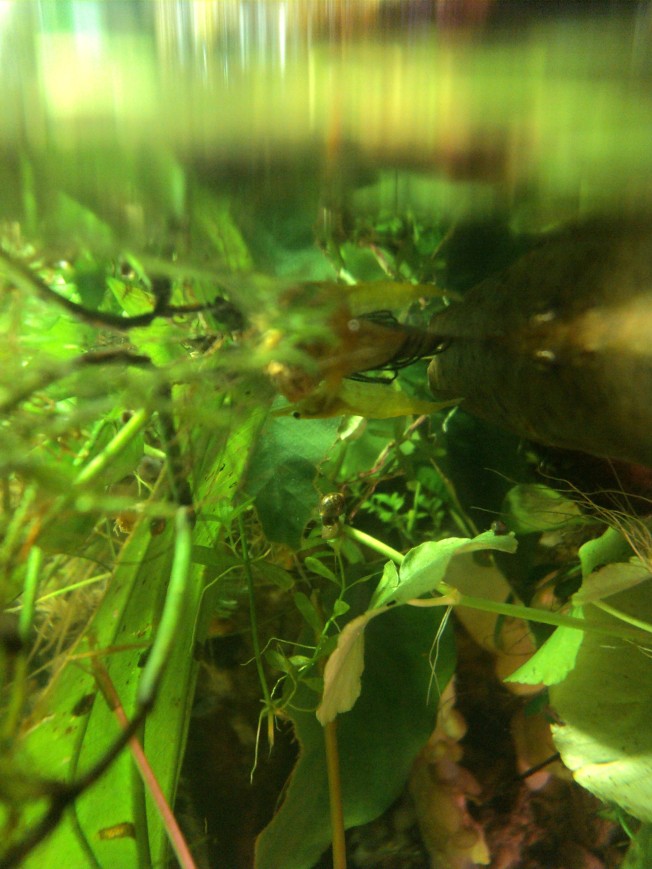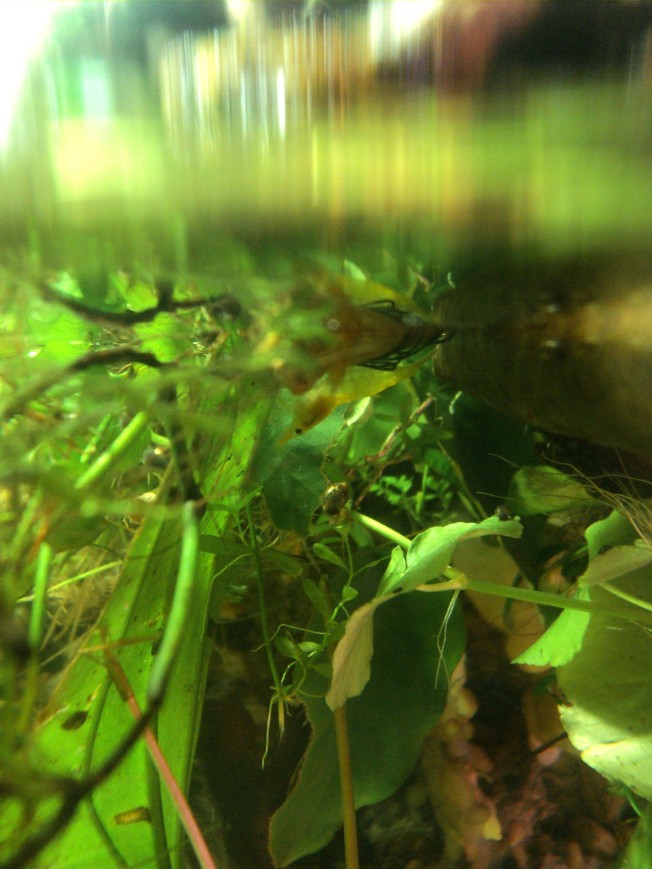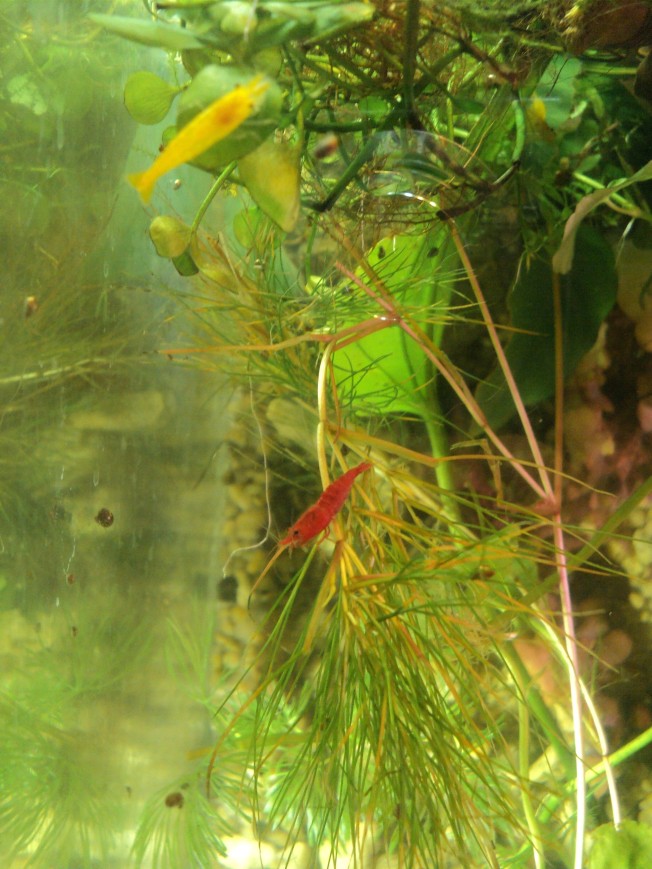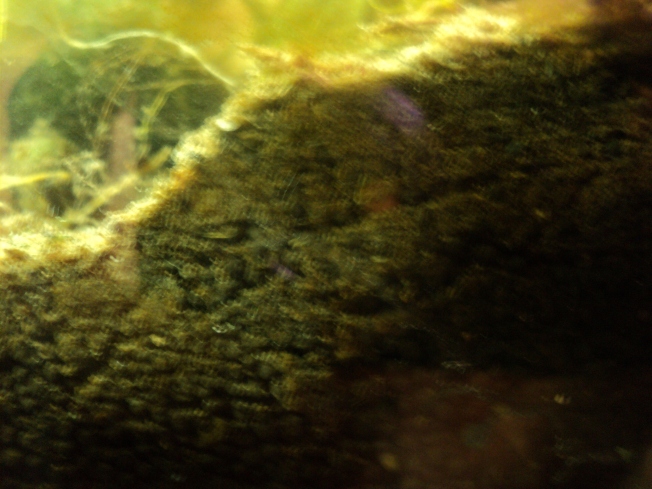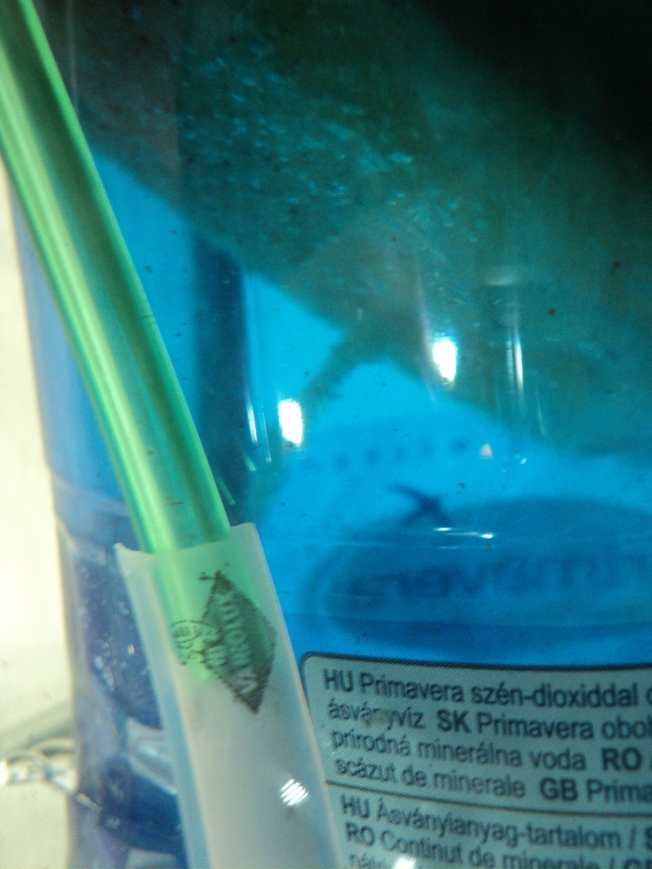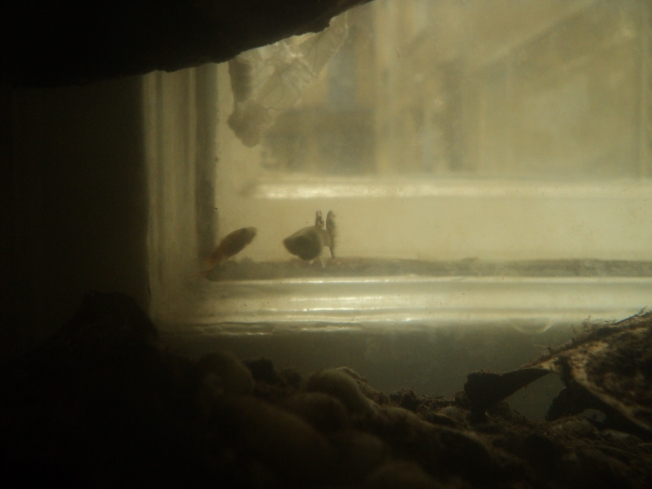Pour l’instant je n’ai pas trouvé à quoi ressemble les oeufs de bb. A lire les articles suivants, les oeufs sont très petits et les larves qui en résultent sont minuscules et ne nagent pas au début, restant au fond ou dans le bois moussu, élément essentiel de leur alimentation. Puis ils commencent à nager après quelques jours ou même semaines et peu à peu se mettent à manger une nourriture vivante moins microscopique. Pour l’instant je nourris les 8 adultes avec des vers de banane et des nauplies que je fais éclore dans une mini bouteille d’eau salée alimentée d’air comme sur cette photo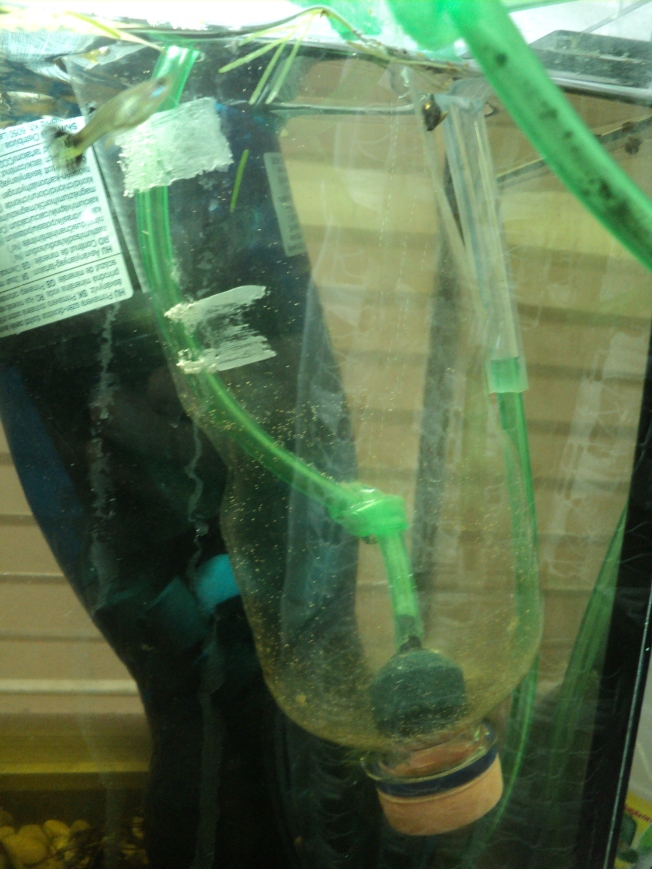
Ils mangent volontier les oeufs de nauplies non éclos mais un peu blanc, je crois que la coquille de l’oeuf de nauplie est plus tendre . Ils s’en gavent! ils dédaignent parfois les nauplies les recrachant à moins que se soit leur façon de manger la nourriture vivante. Les vers de bananes trop microscopique pour être photographier sont avaler tout de suite par contre. . J’ai aussi assisté à un bb mangeant un bébé sangsues de 1cm : il l’a recraché plusieurs fois puis l’a avalé (voir vidéo:
, ce qui me laisse espérer que la colonie de sangsues ne va pas trop se développer…
(Ici le PDF de mon filtre à eau osmosée (english))
3StufenFilterAnleitungEnglisch 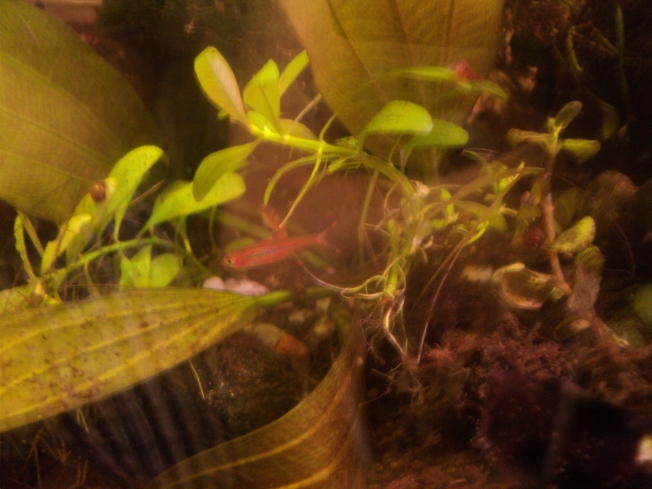
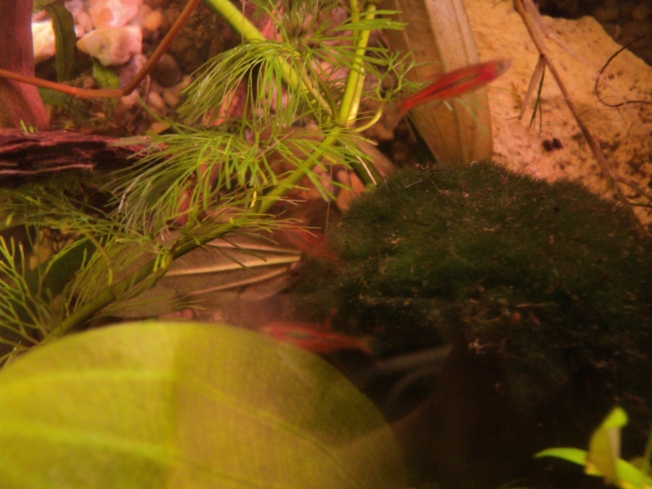
Breeding: I haven’t raised any fry to maturity as they get eaten in the community tank. The fish spawn regularly in the morning, the eggs are usually stuck on the underside of plants. The fry grow well on the tanks micro food hiding among dense vegetation.
Ils pondent le matin lors de leur repas. Les oeufs sont collés sous des feuilles. Les alevins grandissent dans une végétation dense pleine de micro animaux…
_________________________
The female is much paler. My 6 bb are the same color 😦
Maybe I should put more Vallis plants they were cheap and big… (see video)
La réussite de leur reproduction d’après l’article plus bas…
- Breeding: Use at least 3 pair in the spawning group. Eggs are scattered throughout the dense plants or spawning mops. Remove the parents after 2 days as they will eat the eggs and the newly hatched fry. Fry will eat Paramecium or other microscopic food. After one week baby brine shrimp may be fed.
Non pas ce système trop abstrait mais celui plus bas…
by doing a “dance” alongside the other fish, either head-to-head or head-to-tail. He constantly flicks his body and fins at the other fish, while his body coloration intensifies. I assume this behavior shows how strong he is by the pressure wave he creates with the flick. No harm is done; it appears that the display is enough to keep the other males in line.
Voir la danse filmée ici:
Cette danse se fait côte à côte. Un ma^le dominant protège son territoire sur 25 cm en dansant ainsi, ce qui ne veut pas dire qu’il y ait des femelles autour et je crois que je n’ai que des mâles car les couleurs ne sont pas si pâles que pour les femelles…
The dominant male is the only male that I’ve seen spawning with the females. I don’t know whether the other males do any spawning. The dominant male does the dance described above for the females, and separates one of them from the school and coaxes her into his corner of the aquarium. They then spawn among the thickets of crypts or Java ferns, with the dominant male sometimes coaxing the female over Java moss, other times with him coaxing her upside-down under aquatic plant leaves. Some authors report the eggs are laid on the underside of the leaves. They go through this spawning ritual nearly every day, in the early morning just after first light.
Il y a un groupe de mâles et de femelles. Le mâle dominant MD éloigne une des femelles du groupe et danse autour… alors elle pond un oeuf qu’il féconde (spawn) sous une feuille de cryptotorine ou de java, parfois le mâle se met dans l’axe de la femelle (coaxing) sous une mousse, l’un contre l’autre sous une feuille. Il fait ça tous les matin dès la première lumière…

After a few days of watching this ritual, I remove several aquatic plant clumps to a small aquarium for the eggs to hatch out. I fill the fry aquarium with water from the parents’ aquarium, and add a slowly bubbling sponge filter. I also add a piece of old, slimy driftwood from the adults’ aquarium to the fry aquarium. This step seems to be very important to successfully raising the fry.
C’est alors qu’il faut retirer les feuilles de plantes, remplir un bac d’eau de R avec un filtre à faible flux, un bois moussu qui est essentiel à la survie de l’alevin.
After hatching, the fry are so tiny that they are difficult to see. They hang from the aquatic plants for a few days while they finish their development. After about four days, they start to make their first attempts at swimming, darting up into the water column and drifting back downward. After another day or so, they are “free swimming.” That means they are up in the water column all the time, actually swimming. At this point, they are still nearly clear, and they spend most of their time hiding in and among the aquatic plant clump and on the driftwood. This is the point that I start adding fry foods to the aquarium. I add paramecia for the first several days, and then start feeding frozen cyclops along with the paramecia. After they have been swimming for about a week, I start adding newly hatched brine shrimp. The juveniles spend their first month or so in the aquatic plants near the bottom, then start spending more time higher up in the water column. By this time, they are large enough to go into the aquarium with the adults.
Une fois l’oeuf éclos la larve est si minuscule qu’il est difficile de la voir. Pendant quelques jour elle s’accroche à la feuille et se développe lentement… après 4 jours environ, elle se lance pour sa première nage dans le faible courant de la pompe. Après un jour de cet apprentissage elle nage partout. Surtout dans le flux de la pompe. Elle est très claire et se cache souvent parmi les plantes et dans le bois moussu… ce cinquième ou sixième jour on leur donne des paramécies.

Les paramécie pendant plusieurs jours auquel j’ajoute ensuite des cyclopes congelés 
après une semaine de nage (le 11e jour donc) on leur donne en plus des nauplies (brine shrimp comme dans ma petite bouteille)…

Cela dure ainsi un mois où les alevins nagent d’abord au fond puis de plus en plus souvent vers la surface ou dans le flux du filtre…
A un mois les alevins sont assez grands pour revenir dans R.
The entire time they are in the fry aquarium, they are probably mostly feeding on the micro-fauna on the aquatic plants and the bacterial or fungal slime that builds up on the driftwood. That seems to be the key to getting them started in life. I’ve tried spawning the adults in a spawning aquarium like one would with most other egg scatterers, but the fry do not do well, and I’ve not been able to grow them large enough to eat newly hatched brine shrimp.
Dans B pour l’éclosion des alevins, ces derniers probalement commence leur vie en ce nourrissant des micros animaux mais aussi des champignons et bactéries du bois moussu. Sans ce bois pas d’alevins…
On the other hand, when I’ve added a piece of “old” slimy driftwood with Java moss to the fry aquarium, the fry disappear into the Java moss on the driftwood. It’s possible that they feed on the bacterial growth or maybe even some type of fungus that grows on driftwood for the first few days, then switch over to feed on the micro fauna on the aquatic plants. This would be similar to what they would encounter as first fish foods in the leaf litter in the wild, but it’s a lot less messy than adding a bunch of old leaves to the aquarium.
Les alevins disparaissent litéralement dans la mousse du bois. C’est sans doute toute leur nourriture: bactéries et micro-champignons du bois pendant les permiers jours… on pourrait aussi essayer avec des feuilles (de chêne etc.) comme dans leur biotope naturel.
I do not do water changes in the fry aquarium for the first four to five weeks. There aren’t that many fry (usually only a couple dozen), and the live aquatic plants help to maintain water quality. Maintenance of the adults and older juveniles is straightforward. I do regular water changes of about 30 to 50 percent every 7 to 10 days. My pH is 7.2 to 7.4, and the total hardness is about 125 ppm, mostly from carbonates. I use sponge filters in all of my aquariums. Temperatures are kept in the low to mid 70s, and the lights are on for 12 hours a day, on a timer. Adult fish and older juveniles are fed with newly hatched brine shrimp, grindal worms, micro pellets, finely ground quality flake foods and the occasional squirt of a frozen food mixture with garlic when I’m feeding that to other fish in the fish room.
Je laisse l’aquarium des alevins B en paix, pas de changement pendant un mois voir plus…. les alevins sont rarement plus d’une vingtaine, surtout les plantes sont importante dans le bac pour conserver une bonne qualité de l’eau. Dans R on change l’eau tous les 7 10 jours 30 à 50% et le PH se situe entre 7.2 et 7.4 avec un KH de 125 ppm (divisé par 20 on obtient kh=6 environ) grâce à l’apport de CO2 dans l’eau. Lumière 12 h par jour. l’alimentation: nauplies, vers grindals, flocons pour alevins, aliment congelé parfois avec de l’ail (ce que l’on donne aux autres poissons)…

Habitat
__________________
Some males have deep red coloration throughout their bodies, which intensifies with age. Males have bright red fins outlined in black, and females have pale pink/orange fins and lack the deep red on their flanks, with only a hint of pale orange in the body. At least with my fish, the dominant male B. brigittae developed an almost glowing bright red sheen over the entire body but only when he reached about 1 year old. The subdominant males don’t display this glowing coloration.
Seul un mâle dominant de un an se pare d’une ligne verte tout le long du corps. Les mâles sont de plus en plus rouge avec l’âge…
_______
I keep the dwarf redfin rasbora fish in an aquarium by themselves, because they are so
| About the Author Mike Hellweg has been an active aquarist for 30+ years and has been actively breeding fish since he was 9, working almost exclusively with small fishes that mature at 4” or less.With more than 150 species from 20 families, he is the top ranked breeder of all time in his local club. Mike is currently the President of the Missouri Aquarium Society and is on the Board of Directors of the American Livebearer Association. He has written dozens of articles for various hobby publications. He also owns and operates a retail fish business. |
tiny. Their aquarium is a planted 15-gallon aquarium with about 30 to 40 Cryptocoryne wendtii, some Java ferns (Microsorium pteropus) and a couple of pieces of driftwood with Java Moss and Anubias barteri nana attached to it. The adult fish school in the mid to upper third of the water column. A single dominant male controls about 25 percent of the aquarium. He keeps all other fish out of this territory with a surprisingly aggressive defense for such a small fish. He displays for females and “fights” with other males in the same way: by doing a “dance” alongside the other fish, either head-to-head or head-to-tail. He constantly flicks his body and fins at the other fish, while his body coloration intensifies.
Ce mâle dominant a un territoire qu’il défend avec sa danse sur un quart du volume du bac.
______________________
Sexing and breeding
Sexing them is fairly easy. All except B. micros are sexually dichromatic. Males of B. brigittae, B. maculatus and B. merah, when in condition, exhibit a more intense red body colour than the females, which are plumper than males when in condition. Males also exhibit intense black and red markings on dorsal and anal fins.
Males of B. urophthalmoides are not as colourful as males of B. brigittae, B. maculatus or B. merah, but can be easily distinguished from females by a more intense coloration, particularly an orange/yellow stripe above the lateral stripe, the amount of iridescent blue in the lateral stripe and a slimmer overall appearance.
La femelle a une ligne par contre orange ou jaune néon et sa ligne verte est plus mince. Mais l’espèce Bororas micros ne connait pas de différence entre mâle et femelle.
When in good condition males will become more aggressive towards each other, their colours will intensify and they will begin fighting for and defending a small territory. Once they have established one they will begin to display and, if the female shows herself to be receptive, spawning should be imminent.
Si les poissons sont en bonne santé après un certain temps les mâles dansent plus les uns contre les autres, leurs couleurs s’intensifie et ils s’installent dans leur petit territoire qu’ils défendent en dansant… une fois installés ils attirent la femelle et fécondent leurs oeufs… toujours en dansant.
THE END
Photos de A et B:
Pour ce qui est de l’amonia: les deux pompes diy marchent à merveille puisque maintenant l’amonia est nul dans A et B (aquariums à la fenêtre A et B)
Voici Caline la furette qui s’amuse avec les aquariums il y a deux semaines…
Et hier les stores vénitiens étant installés:
